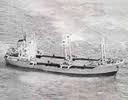Shipwreck M/V Kormoran
This General Cargo vessel was built by VEB Schiffwerft in their Neptun yard at Rostock, in the former East Germany and launched as the “Kormoran” in 1963. She sailed under that name until 1976 when her name was changed to “Adamastos.” In 1980, yet another change of owner saw her renamed Zingara.
A rather smart ship of 1,582 gross registered tonnes, her dimensions were 82.4m x 12.6m with a draught of 4.25m. The Zingara’s hull was “ice-strengthened” and comprised 2 cargo holds forward with engine room and bridge located at the stern. She was powered by a 6 cylinder diesel engine capable of producing 1,365 BHP and a top speed of 12 knots.
The Zingara was owned and operated by Montemare di Navigazione S.p.a. and registered in Naples at the time of her loss.
The Loss of the Zingara
The Zingara sailed from the Jordanian port of Aqaba on 21st August 1984 with a cargo of Phosphate Rock. The following day she ran aground on Laguna Reef immediately north east of Jackson Reef and was subsequently declared a total constructive loss.
Two factors arising from the wrecking of this ship have given cause for considerable speculation. The Straits of Tiran are that narrow stretch of water between the Sinai Peninsular and Tiran Island offering the only access to the Gulf of Aqaba and, with it, Jordan’s only seaport from which the Gulf takes its name.
Four magnificent coral reefs are found right in the centre of the Straits making this narrow interface between the Red Sea and the Gulf of Aqaba all the more narrower. Jackson Reef is the most northerly of these reefs and Gordon Reef the most southerly. Ominously, they are both marked by the prominent shipwrecks “Lara” and “Loullia” respectively – a clear warning for all vessels entering and leaving the Gulf of Aqaba to exercise extreme care. Understandably, therefore, the rule of the road is keep right with “up” traffic entering the Gulf being required to take the eastern route between those reefs and Tiran Island and “down” traffic keeping to the west. All charts are clearly marked with this requirement.
It was, therefore, somewhat strange that the fully loaded Zingara hit the reef on the eastern side of the Straits – when a southerly course demanded a westerly route. Furthermore, there is no doubt that the ship struck the reef with such considerable force as to be driven hard onto the reef removing her bottom completely.
Sources: Internet





